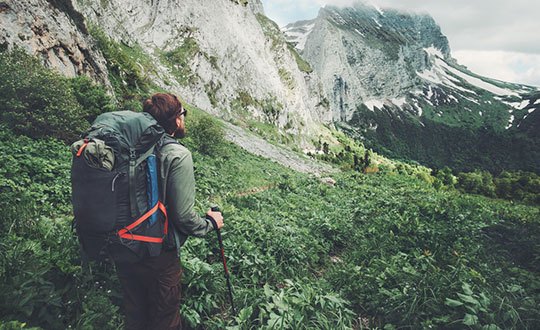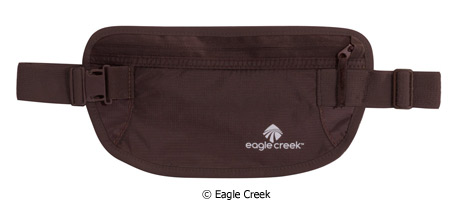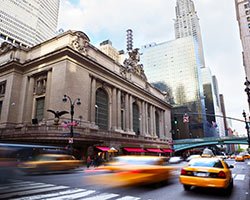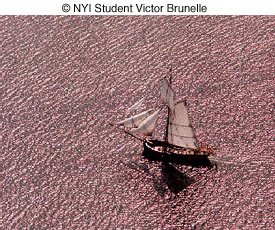
Raise high the mainsail! Batten down the hatches! All hands to the poop deck! Port outbound, Starboard home!
OK, we admit it. We don't know much about nautical terminology or naval protocol. A sextant is a useless tool in our hands, and we never know when to tack. But we do know a few things about cameras and boats — the most important being that they go well together. At the risk of punning — photo opportunities abound on the bounding main!
So, even if you can't tell a barkentine from a frigate, read on and enjoy these boat photo tips and creative ideas that will help you take great boat photographs. Then ... Mark Twain! ... and meet us under the Mizzenmast!
Let's be serious for a moment. Photo industry research shows that the vast majority of boat owners also own cameras and that they use them often to take pictures while boating. Another thing we know is that just about every boat owner loves pictures of his or her pride-and-joy boat. And boat owners also love pictures of themselves on their boats. That's one reason we photographers get invited aboard so many boats. Smile, Skipper!
Before we carry our camera aboard, there's one key point to consider: Water. Water, water, everywhere. We mean water spray, salt water spray, rain, foam, waves, and, Ahab forbid, dropping the camera into the drink. Cameras don't take kindly to water. The main thing to remember when doing boat photography is to always protect as much of your gear as possible.
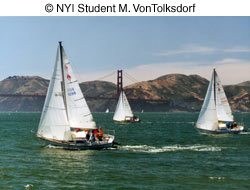
Lots of times we'll work with the top of our camera bag open so we can pull out accessories or change lenses easily. But watch out if there's any possibility of a wave splashing over your gear. Keep your bag closed. The other point we emphasize: If your camera gets dunked in fresh water when taking boat photos, dry it out and get it to a camera repair center as fast as you can.
Now, let's get down to the specifics of boating photography. Regardless of whether your boat is a canoe, a runabout, or a yacht, there are basically three types of boating photos you're likely to take — pictures of people (including yourself) on your boat, pictures shot from your boat and, finally, pictures of your boat (and of other eye-catching boats that you encounter in your travels). Let's look at each type of photograph separately.
Boating Photography Tips — Pictures of People on your Boat.
For all three types of photos, including our boating photography tips, we start with NYIP's Three Guidelines. These Guidelines are just as valid on water as on land. Always ask yourself: One: What is the subject of my photograph? Two: How can I emphasize that subject? Three: What can I do to simplify the picture by eliminating any elements that distract from my subject?
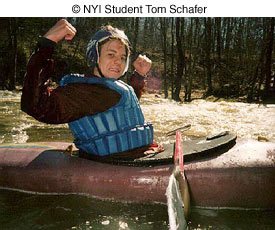
This picture is a perfect example of a tight shot that shows most of the boat, the skipper and the entire crew. The subject is a rough-and-ready kayaker, pumped up and set to run the rapids. While taking boat photos, the photographer came in close and made his subject — the kayaker — nice and big in the frame, and there's nothing to distract from the scene. The bare trees on the river bank and the fast-running water tell us it's probably early spring. Our feet get cold just looking at this shot!
Note an important technical point. In the case of this picture the sun glances off the top of the subject's head. Since most boating pictures are taken in full sunlight, be aware of a potential problem. Watch the direction of the sun carefully. If you face your subject toward the sun, he or she will probably squint. To avoid this squint, you will often turn the skipper's face away from the sun as this photographer did. While this avoids the squint, it places the face in shadow. This is the problem. You have to add light to the shadowed face. So watch out. If the face is in shadow, and add fill-flash, as Tom did in this winner of a shot.
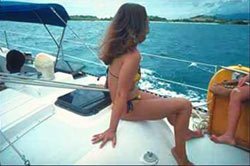
Here's an example of a lousy photo of someone on a boat. First and foremost, it's not clear what the photographer intended the subject to be. It's probably the bikini-clad woman in the foreground, but we see lots of yacht and a good deal of scenery in the background, both of which fight with her for predominance in the scene — not what you want in well-thought out boat photos. Let's assume she's the subject. To emphasize her it would make sense to see her face, and perhaps have her eyes make contact with the camera lens. NYIP Guideline Three asks how we can simplify the scene. This photo is a mess. Her foot is cut off at an awkward spot, there's a disembodied set of legs on the right, and lots of boat gear on the left. How would we correct this? We would suggest that the photographer move a little to the right to eliminate the person on the left, come in a little closer to the woman to make her more dominant in the frame, and ask her to turn her head toward the camera and smile.

Now let's look at an example of a great portrait made in a small boat. The subject is clearly this smiling woman. The background is a simple combination of overhanging tree branches and a bit of water. The soft light on her face is perfect for portraiture. And, this looks like a romantic spot! However, this picture raises a question. From the angle at which it's shot, we think the photographer was probably standing up. On a boat. On a very small boat! This can be dangerous both for the photographer and his camera...and for the young lady, too, if the boat turns over. Too much motion is one of the key problems for the photographer on any boat, whether it's tied up alongside the dock or cruising in open water. So, safety first. If you're in an unstable craft, try to shoot boat photos without standing up. If you must stand up, spread your legs wide to lower your center of gravity and give you a more solid base. And, if possible, find something solid to lean against.
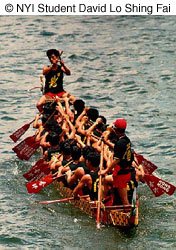
There's another aspect to shooting from a rocking boat. For example, imagine trying to stand to take pictures on this dragon boat. You bet there's lots of rolling and tossing in Hong Kong Harbor. In addition to bracing yourself, use a fast shutter speed. To use a fast shutter speed, you'll need a fast ISO. ISO 400 or faster should be your standard at-sea ISO. If you're using a point-and-shoot or an auto-exposure SLR that has a "sports mode," use it. This mode will bias the exposure toward a fast shutter speed and compensate with a large aperture.

Another point: Watch out for clutter on the deck. Boats of all sizes are filled with clutter. And clutter in your picture will only distract from your subject. When we look back upon this picture, we see clutter everywhere — the blue cushion, the aluminum poles, the blue awning, the yellow seat, the chrome fittings, etc. Remember Guideline Three: Simplify. Shoot in a way that will make the clutter "disappear." For example, get in close and fill the frame with your subject. Use a wide aperture so that the background clutter is thrown out of focus. Most of all, look for clutter in your viewfinder — examine the image carefully, especially around the edges — and figure out a way to make the clutter "disappear."
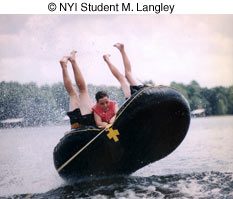
Another problem arises when you photograph people on water skis or a raft being towed behind your speedboat. You need to stop the action. And this takes a fast shutter speed, the faster the better..
To sum up the key tips for pictures of people taken on board your boat, remember to follow NYIP's Three Guidelines, use a fast shutter speed to combat motion, and make sure to simplify and avoid onboard clutter.
Boating Photography Tips — Taking Photographs From a Boat.
Everything we've covered regarding taking pictures of onboard people also applies to anything you may want to photograph from a boat. Whether you train your camera on a scenic harbor, the shoreline, or another boat, follow the Three Guidelines, use a fast shutter speed, and guard against showing too much on-board clutter.
Don't get carried away by the endless variety of the scenery, and shoot without thinking.
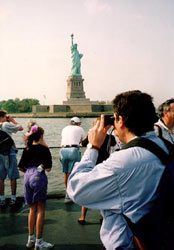
For example, here we see a gung-ho tourist taking that once-in-a-lifetime view of the Statue of Liberty as the boat pulls into Liberty Island. How many of the people in the shot do you think he knows? Our guess is he would happily eliminate all of them. Wouldn't he have been smarter to take a few seconds and walk to the railing and shoot from there?
Now, you may wonder if you should use a tripod, especially on a rocking boat? If you are shooting a picture of someone on the boat — for example, the skipper — fine. A tripod will provide a solid base for boat photos when the subjects are within the boat. But if you're shooting anything outside the boat —for example, the shoreline — don't! Why? Because the tripod will rock with the boat. If your subject is also rocking with the boat —like the on-board skipper — a tripod may help. But if your subject is not rocking with the boat —like the shoreline —then the tripod will do a worse job of stabilizing your camera than you can by simply handholding it. In this "shoreline" situation, don't try to rest your camera on a deck railing or any other sturdy shipboard object. Your body is likely to be the best absorber of all. We suggest you stand with legs spread, a slight bend in your knees to act as shock-absorbers, and use a very fast shutter speed.
Boating Photography Tips — Taking Photographs of Boats.
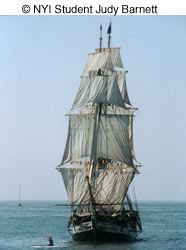
Naturally, one of the subjects you're likely to want to photograph will be other boats — or your own. Very simply, they make great subjects for our cameras. Like the human body, musical instruments, and flowers, boats please the eye. Who wouldn't want to take a picture of an old sailing ship or a racing boat with its spinnaker out?
You may shoot boat photos while you're standing on the shore...or you may be aboard another boat. Either way, start by observing the Three Guidelines. What makes this picture of the boat so appealing is its unadulterated simplicity. There's the boat and its sail, big and bold. There's the sea and there's the sky. That's all! The boat pretty much fills the frame — and there's nothing else to distract us.
With boat pictures, be aware of the possibilities for weather to make your subject more interesting. We always love to see beautiful ships with bright blue skies behind them, but we recently received a pair of very similar photos from NYIP student David Harding where he photographed the same boatyard under two drastically different weather and lighting conditions.

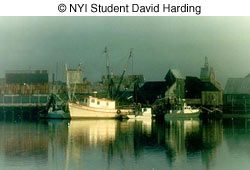
Which of these two pictures do you think works better — the one in bright sun or the one in misty dusk? We think the sunny shot is too busy. We see too much that distracts from the boats. Not so in the misty image. In this case the mist and semi-darkness obscure the distracting details of the background. Only the white boats stand out. (Of course, it doesn't hurt that the water was smoother, producing those beautiful reflections.)
Placement is also crucial. For example, compare these two pictures:
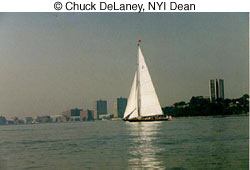
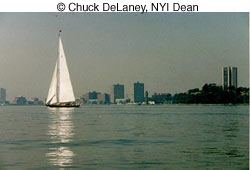
As we've said in other articles on this Web site, when you photograph a moving object always allow space in front of it into which it can move —that is, provide lead room. The boat is moving from right to left. As you can see, the first picture gives it plenty of lead room, but the second picture doesn't. Always provide a moving boat with enough lead room!

Finally, keep your eye out for details when taking boat photos, especially on big ships. Here's the anchor on the aircraft carrier Intrepid, which is a museum in New York harbor. It's an interesting detail.
In summary, if you follow these simple tips, you'll be able to take great boating photos with your point and shoot or DSLR.


